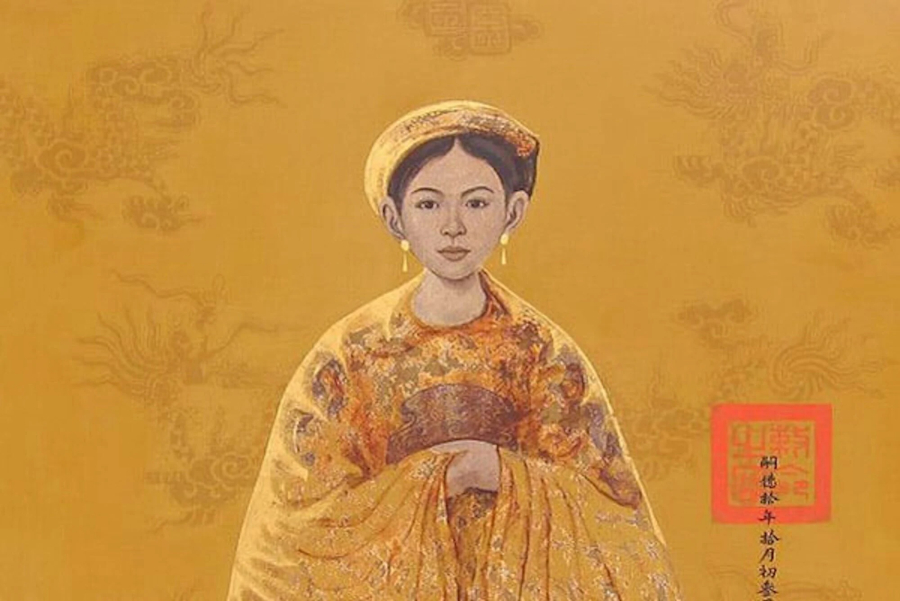Dương Vân Nga held the position of the queen consort in two early dynasties of Vietnamese history, serving both Đinh Tiên Hoàng and Lê Đại Hành. She had a significant influence in the power transition from the Đinh dynasty (968 – 979) to the Early Lê dynasty (980 – 1009), playing a crucial role in this important historical event.

Dương Vân Nga held the position of the queen consort in two early dynasties of Vietnamese history, serving both Đinh Tiên Hoàng and Lê Đại Hành
Lê Ngọc Bình, another important figure, became a concubine for two kings from contrasting dynasties in the late feudal period of Vietnam’s history, the Tây Sơn dynasty (1778 – 1802) and the Nguyễn dynasty (1802 – 1945).
When Quang Trung passed away in 1792, Quang Toản was only 10 years old and too young to assume power, leading to the regent Bùi Đắc Tuyên seizing power. The internal divisions and power struggles among the generals weakened the strength of the Tây Sơn dynasty, contributing to its downfall.
By 1795, when Bùi Đắc Tuyên was removed from power and external control was no longer present, Queen Lê Ngọc Hân of the Northern palace nominated her younger sister, Lê Ngọc Bình, to enter the palace and marry Quang Toản, who now became Emperor Cảnh Thịnh Nguyễn Quang Toản. Lê Ngọc Bình, then 12 years old, was appointed as the Chief Concubine of the Imperial Palace. However, during her 6 years in the palace, she did not give birth to a successor.

Lê Ngọc Bình became a concubine for two kings from contrasting dynasties, the Tây Sơn dynasty (1778 – 1802) and the Nguyễn dynasty (1802 – 1945).
In the final stage of the Tây Sơn dynasty, internal chaos and conflicts weakened the power of the imperial court, resembling the idiom “a pot boils the meat”. Taking advantage of this opportunity, Lord Nguyễn from Gia Định launched a northern expedition, and within 10 years, Nguyễn Ánh had reestablished influence in Đàng Trong, forcing the Tây Sơn emperor to retreat to the north.
According to “Quốc sử di biên,” a historical work written by Phan Thúc Trực in 1852 during the reign of Emperor Tự Đức, it is recorded: “In the year Nhâm Tuất, the first year of Gia Long’s reign 1802… on the 21st day of the lunar month Canh Thân, the founding emperor (Gia Long) arrived in Thăng Long and captured Nguyễn Quang Toản and presented them to the royal court… and also brought Lê Ngọc Bình into the imperial palace…”
In the same year, 1802, Cảnh Thịnh and the Tây Sơn court were captured and later executed in Huế, marking the end of the Tây Sơn dynasty. Lê Ngọc Bình, after this event, was chosen by Gia Long to be his concubine.
When officials objected, saying, “The emperor now rules the entire realm and lacks no beautiful women, why marry the wife of the enemy?” Gia Long replied: “We have conquered the enemy’s land, so what’s stopping us from taking their wives? If we can conquer their land, then marrying the enemy’s wife is not impossible!” (quoted by Trần Quốc Vượng in the book “Mấy vấn đề về vua Gia Long”).

Lê Ngọc Bình, bestowed with the title of the Empress of Virtuous Deeds by Emperor Gia Long
Lê Ngọc Bình, bestowed with the title of the Empress of Virtuous Deeds by Emperor Gia Long, gave birth to two princes and two princesses: “The eldest prince is Quảng Uy công Nguyễn Phúc Quân, the second prince is Thường Tín công Nguyễn Phúc Cự, the eldest princess is An Nghĩa công chúa Ngọc Ngôn, and the second princess is Mỹ Khê công chúa Ngọc Khuê” (according to page 222 of “Nguyễn Phúc tộc Thế phả”).
Lê Ngọc Bình passed away at the age of 25, very young, and was given the posthumous title Cung Thận Đức Phi by Emperor Gia Long. She was buried in Trúc Lâm village, Huong Tra town, present-day Thừa Thiên Huế province.
Lê Ngọc Bình and her older sister, Lê Ngọc Hân, both daughters of Emperor Lê Hiển Tông of the Hậu Lê dynasty, were born in the north and both became concubines in the Phú Xuân palace under the Tây Sơn dynasty.
The important similarities in the lives of these two sisters have led to confusion between Ngọc Hân and Ngọc Bình in folklore. Although there is speculation that Gia Long took Lê Ngọc Hân, the wife of King Quang Trung, as an act of revenge, in reality, Lê Ngọc Hân passed away in 1799, while Gia Long only ascended to the throne and established the Nguyễn dynasty in Phú Xuân (Huế) in 1802.
Lê Ngọc Bình had an unusual fate with two husbands who were both emperors: firstly, King Cảnh Thịnh Quang Toản of the Tây Sơn dynasty, and secondly, Emperor Gia Long Nguyễn Ánh. This story has become a subject of folklore, with a folk verse stating: “How strange is fate/ The daughter of kings becomes the wife of two kings.”














